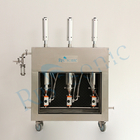
loading


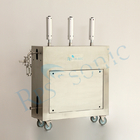

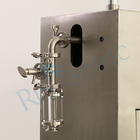

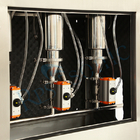

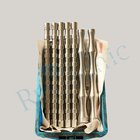

| Availability: | |
|---|---|
| Quantity: | |
| Place of Origin | China |
|---|---|
| Brand Name | Rps-sonic |
| Certification | CE |
| Model Number | RPS-SONO20-3 |
| Minimum Order Quantity | 1pcs |
| Price | negotiable |
| Packaging Details | CARTON |
| Delivery Time | 1DAYS |
| Payment Terms | T/T |
| Supply Ability | 200PCS/MONTH |
20Khz three in one Ultrasonic Extraction equipment for CBD oil extracting
Parameter
| Model | SONO20-1000 | SONO20-2000 | SONO15-3000 | SONO20-3000 |
| Frequency | 20±0.5 KHz | 20±0.5 KHz | 15±0.5 KHz | 20±0.5 KHz |
| Power | 1000 W | 2000 W | 3000 W | 3000 W |
| Voltage | 220/110V | 220/110V | 220/110V | 220/110V |
| Temperature | 300 ℃ | 300 ℃ | 300 ℃ | 300 ℃ |
| Pressure | 35 MPa | 35 MPa | 35 MPa | 35 MPa |
| Intensity of sound | 20 W/cm² | 40 W/cm² | 60 W/cm² | 60 W/cm² |
| Max Capacity | 10 L/Min | 15 L/Min | 20 L/Min | 20 L/Min |
| Tip Head Material | Titanium Alloy | Titanium Alloy | Titanium Alloy | Titanium Alloy |
Description
An ultrasonic extraction machine uses high-frequency ultrasonic waves to extract bioactive compounds from plant materials. This innovative technology is widely used in pharmaceuticals, food processing, cosmetics, and research due to its efficiency, environmental friendliness, and ability to preserve delicate compounds.
Working principle
Ultrasonic cavitation can locally lead to extreme conditions such as very high differential pressures and high shear forces. When cavitation bubbles burst onto the surface of solids (e.g. particles, plant cells, tissues, etc.), microjets and inter-particle collisions can produce effects such as particle rupture, sonoporation (perforation of cell walls and membranes), and cellularity. Furthermore, the bursting of cavitation bubbles in liquid media creates turbulence and agitation, which facilitates mass transfer between the interior of the cell and the surrounding solvent. Ultrasonic radiation is an efficient way to enhance mass transfer processes, as ultrasound induces cavitation and its associated mechanisms, such as micromotion induced by liquid jets, compression and decompression in materials and subsequent cell wall disruption.
Transducer and Probe: Converts electrical energy into ultrasonic vibrations and delivers them to the extraction medium.
Control System: Allows adjustment of frequency, power, and time for optimal extraction.
Temperature Management: Prevents overheating of heat-sensitive compounds with built-in cooling systems or water baths.
Solvent Compatibility: Works with a wide range of solvents (e.g., water, ethanol, isopropanol, or oil-based solvents).
High Efficiency: Extracts a higher yield of compounds in less time compared to traditional methods (e.g., Soxhlet, maceration).
Low Temperature: Protects heat-sensitive compounds, preserving bioactivity.
Environmentally Friendly: Reduces solvent usage, making it a greener alternative.
Versatile: Can process a variety of plant materials and bioactive compounds.
Scalable: Suitable for both laboratory-scale and industrial-scale operations.

20Khz three in one Ultrasonic Extraction equipment for CBD oil extracting
Parameter
| Model | SONO20-1000 | SONO20-2000 | SONO15-3000 | SONO20-3000 |
| Frequency | 20±0.5 KHz | 20±0.5 KHz | 15±0.5 KHz | 20±0.5 KHz |
| Power | 1000 W | 2000 W | 3000 W | 3000 W |
| Voltage | 220/110V | 220/110V | 220/110V | 220/110V |
| Temperature | 300 ℃ | 300 ℃ | 300 ℃ | 300 ℃ |
| Pressure | 35 MPa | 35 MPa | 35 MPa | 35 MPa |
| Intensity of sound | 20 W/cm² | 40 W/cm² | 60 W/cm² | 60 W/cm² |
| Max Capacity | 10 L/Min | 15 L/Min | 20 L/Min | 20 L/Min |
| Tip Head Material | Titanium Alloy | Titanium Alloy | Titanium Alloy | Titanium Alloy |
Description
An ultrasonic extraction machine uses high-frequency ultrasonic waves to extract bioactive compounds from plant materials. This innovative technology is widely used in pharmaceuticals, food processing, cosmetics, and research due to its efficiency, environmental friendliness, and ability to preserve delicate compounds.
Working principle
Ultrasonic cavitation can locally lead to extreme conditions such as very high differential pressures and high shear forces. When cavitation bubbles burst onto the surface of solids (e.g. particles, plant cells, tissues, etc.), microjets and inter-particle collisions can produce effects such as particle rupture, sonoporation (perforation of cell walls and membranes), and cellularity. Furthermore, the bursting of cavitation bubbles in liquid media creates turbulence and agitation, which facilitates mass transfer between the interior of the cell and the surrounding solvent. Ultrasonic radiation is an efficient way to enhance mass transfer processes, as ultrasound induces cavitation and its associated mechanisms, such as micromotion induced by liquid jets, compression and decompression in materials and subsequent cell wall disruption.
Transducer and Probe: Converts electrical energy into ultrasonic vibrations and delivers them to the extraction medium.
Control System: Allows adjustment of frequency, power, and time for optimal extraction.
Temperature Management: Prevents overheating of heat-sensitive compounds with built-in cooling systems or water baths.
Solvent Compatibility: Works with a wide range of solvents (e.g., water, ethanol, isopropanol, or oil-based solvents).
High Efficiency: Extracts a higher yield of compounds in less time compared to traditional methods (e.g., Soxhlet, maceration).
Low Temperature: Protects heat-sensitive compounds, preserving bioactivity.
Environmentally Friendly: Reduces solvent usage, making it a greener alternative.
Versatile: Can process a variety of plant materials and bioactive compounds.
Scalable: Suitable for both laboratory-scale and industrial-scale operations.









Ultrasonic Welding Equipment Ultrasonic Welding Transducer Ultrasonic Welding Converter Ultrasonic Liquid Processor Ultrasonic Cutting Equipment Ultrasonic Spray Nozzles Ultrasonic Power Supply Ultrasonic Soldering Equipment Ultrasonic Welding Horn Ultrasonic Assisted Machining Ultrasonic Testing Equipment